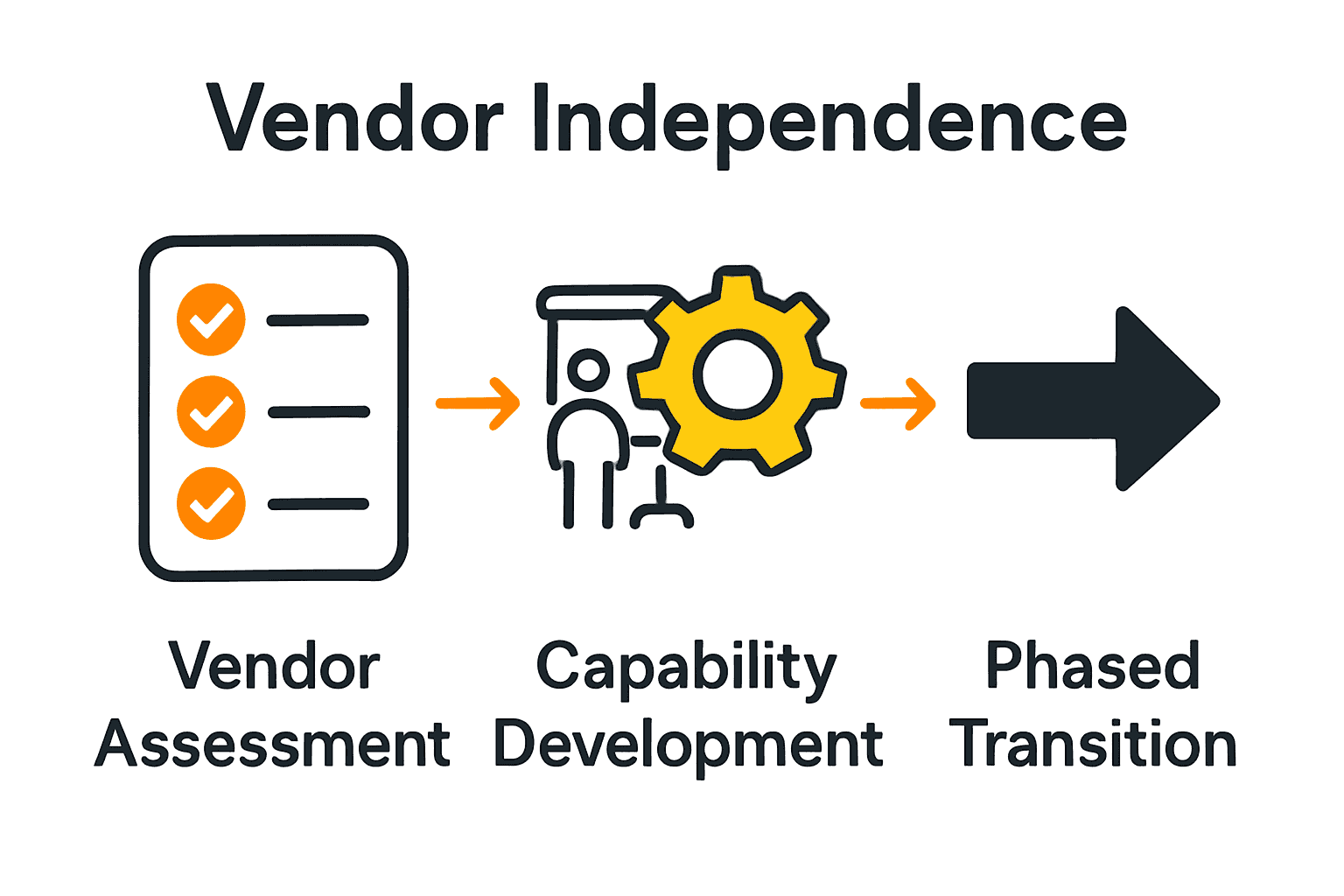Complete Guide to Building Your Vendor Replacement Roadmap

Did you know regional businesses can spend over $1 million each year on external service vendors? These hidden costs often slip under the radar and quietly eat away at growth. When a company relies on multiple vendors, it risks losing control and missing out on long-term savings. A well-defined vendor replacement roadmap shows how to build internal strengths, reduce spending, and turn everyday expenses into new opportunities for lasting business growth.
Table of Contents
- Defining A Vendor Replacement Roadmap
- Common Vendor Categories And Costs
- Steps To Vendor Independence And Ownership
- Calculating And Realizing Annual Savings
- Avoiding Common Pitfalls And Dependency Traps
Key Takeaways
| Point | Details |
|---|---|
| Strategic Vendor Replacement Roadmap | A structured roadmap aids in transitioning from external vendors to internal capabilities, ensuring cost efficiency and operational continuity. |
| Common Vendor Categories | Regional businesses can save 5-30% by consolidating vendor categories and developing internal capabilities, addressing significant hidden expenses. |
| Path to Vendor Independence | Achieving independence involves a phased approach, focusing on internal capability development and systematic vendor replacements to enhance long-term efficiency. |
| Avoiding Dependency Traps | Businesses must navigate potential pitfalls, such as strategic misalignment and implementation resistance, to prevent ongoing vendor dependency and promote innovation. |
Defining a Vendor Replacement Roadmap
A vendor replacement roadmap represents a strategic blueprint for systematically transitioning from existing external service providers to internally managed capabilities. According to Gartner, this comprehensive framework outlines the essential activities required for successfully switching technology providers while meticulously tracking potential transition costs.
The roadmap typically encompasses several critical stages that help businesses methodically replace vendors across different functions. According to Technology Match, these stages often include:
- Intake and Assessment: Evaluate current vendor relationships and identify replacement opportunities
- Selection: Research and identify potential internal capabilities or alternative providers
- Transition Planning: Develop detailed migration strategies with specific timelines and resource allocations
- Implementation: Execute the planned vendor replacement with minimal operational disruption
- Performance Monitoring: Track key metrics to ensure successful transition and continued operational effectiveness
For regional businesses spending $50K-$150K monthly on external vendors, a well-structured vendor replacement roadmap isn’t just a document—it’s a strategic tool for reclaiming control, reducing dependency, and redirecting resources toward core business passions. The goal isn’t simply to switch providers, but to systematically build internal capabilities that can consistently deliver high-quality outcomes at a fraction of the external vendor cost.
Common Vendor Categories and Costs
Regional businesses typically spend between $50K-$150K monthly across multiple vendor categories, creating complex and often inefficient external service dependencies. According to Rohmate’s Vendor Consolidation Guide, companies can reduce costs by 5-30% through strategic vendor category consolidation and internal capability development.
The most common vendor categories that drain operational budgets include:
Here’s a summary of common vendor categories and their typical functions:
| Vendor Category | Typical Functions | Estimated Monthly Spend |
|---|---|---|
| Marketing Agencies | Digital ads Email campaigns Social media |
$10K-$40K |
| Tech Implementation | Software integration Custom development Consulting |
$10K-$35K |
| Creative Services | Design Branding Video production |
$5K-$20K |
| Growth Consultants | Strategy Business development Research |
$5K-$15K |
| Operational Consultants | Process optimization Efficiency analysis |
$5K-$15K |
- Marketing Agencies: Digital advertising, email campaigns, social media management
- Technology Implementation Partners: Software integration, custom development, tech consulting
- Creative Services: Graphic design, branding, video production, content creation
- Growth Consultants: Strategic planning, business development, market research
- Operational Consultants: Process optimization, efficiency analysis, organizational design
For a typical $40-75M regional business, these vendor relationships can represent significant hidden expenses.
While individual vendor contracts might seem reasonable, the cumulative cost often exceeds $500K annually. The real opportunity lies not just in reducing these expenses, but in transforming external dependencies into internal capabilities that drive sustainable competitive advantage. By systematically replacing vendors with AI-enabled internal teams, businesses can redirect substantial resources toward their core passion and strategic growth.

Steps to Vendor Independence and Ownership
Vendor independence is more than a strategy—it’s a systematic approach to reclaiming control of your business capabilities. According to Technology Match’s Vendor Management Lifecycle Guide, achieving true ownership requires a structured, multi-stage approach that transforms external dependencies into internal strengths.
The key steps to vendor independence include:
- Comprehensive Vendor Assessment
- Audit current vendor relationships
- Quantify total monthly and annual spending
- Identify mission-critical versus replaceable services
- Calculate potential internal replacement costs
- Strategic Capability Development
- Map existing internal skills and knowledge gaps
- Design targeted training programs
- Leverage AI tools to accelerate skill acquisition
- Create learning pathways for team members
- Phased Transition Execution
- Prioritize vendor replacements by cost and complexity
- Develop pilot programs for low-risk function transitions
- Implement robust knowledge transfer mechanisms
- Monitor performance through clear Key Performance Indicators (KPIs)

As Unity Connect’s Outsourcing Strategies emphasizes, successful vendor independence isn’t about immediate total replacement, but strategic, measured transitions that minimize disruption while maximizing long-term operational efficiency. For regional businesses spending $50K-$150K monthly on external vendors, this approach represents not just a cost-saving measure, but a fundamental reimagining of how business capabilities are developed and maintained.
Calculating and Realizing Annual Savings
For regional businesses spending $50K-$150K monthly on external vendors, strategic cost reduction isn’t just a financial exercise—it’s a pathway to reclaiming operational control. According to Ramp’s Supplier Management Guide, businesses can unlock substantial savings through targeted procurement strategies that go beyond simple cost-cutting.
Key approaches to calculating and realizing annual savings include:
- Comprehensive Vendor Spend Analysis
- Audit total monthly vendor expenditures
- Identify high-cost and redundant service categories
- Calculate potential savings across multiple vendor relationships
- Develop granular cost reduction targets
- Dynamic Pricing and Negotiation Strategies
- Use performance scorecards to reallocate vendor spending
- Consolidate vendor contracts to leverage volume discounts
- Implement competitive bidding processes
- Establish clear cost-reduction benchmarks
As demonstrated by Ivalua’s Procurement Transformation Case Study, systematic vendor management can yield impressive financial outcomes. Their research revealed a concrete example of how businesses can achieve up to 19% annual cost savings over four years through disciplined vendor relationship management. For a $40-75M regional business, this could translate to $200K-$500K in annual savings—resources that can be reinvested directly into core business capabilities and strategic growth initiatives.
Avoiding Common Pitfalls and Dependency Traps
Building vendor independence requires more than good intentions—it demands strategic awareness of potential roadblocks that can derail transformation efforts. According to Technology Match’s Vendor Management Lifecycle Guide, businesses frequently fall into subtle dependency traps that undermine their strategic objectives.
Common pitfalls to avoid include:
- Strategic Misalignment
- Conflating vendor engagement with genuine capability building
- Conducting superficial, one-off risk assessments
- Relying on soft Service Level Agreements (SLAs)
- Falling into automatic contract renewal cycles
- Implementation Resistance
- Underestimating internal team adaptation challenges
- Failing to address cultural barriers to change
- Neglecting comprehensive skills development
- Protecting existing vendor relationships over business growth
As Rohmate’s Vendor Consolidation Guide cautions, successful vendor replacement isn’t just about cutting costs—it’s about managing complexity, service quality concerns, and organizational resistance. For regional businesses spending $50K-$150K monthly on external vendors, the real risk isn’t in replacing vendors, but in perpetuating dependency cycles that drain resources and stifle internal innovation. The goal is clear: transform external dependencies into sustainable, AI-enabled internal capabilities that drive genuine competitive advantage.
Cut Your $50K-$150K Monthly Vendor Spend by 30-40% and Reclaim What You Love
The guide you just read highlights how regional businesses face a hidden burden paying vendors month after month across marketing agencies, tech implementers, growth consultants, and more. Spending up to $150K monthly is not just a line item. It is real money draining your ability to invest in the passion that built your business. You did not start your company to manage complicated vendor relationships or juggle consultants. It is time to break free from vendor dependency by building internal teams empowered with AI as invisible infrastructure. This approach does not mean adopting flashy tools or chasing trendy solutions. It means cutting $200K-$500K annually by replacing multiple vendor categories with internal capability you own.
At Average Robot, we specialize in helping $40-75M regional businesses across the Midwest and Southeast execute exactly this strategy. With our proven four-step approach you get detailed clarity on your current outsourcing costs, a prioritized vendor replacement strategy, and pilot projects designed to deliver $75K-$150K in immediate savings from one vendor replacement alone. Our clients tell us they finally get to spend less managing vendors and more time focused on what they love.
Stop paying for work your team could own. Fire your consultants and disrupt the dependency cycle today.
Take your first step with a free Vendor Dependency Assessment to map your total monthly spend and spot immediate savings opportunities.

See how your $50K-$150K monthly vendor spend breaks down and start cutting outsourcing costs 40%. Visit Average Robot now to schedule your no-pressure assessment and gain control over your vendor replacement roadmap.
Frequently Asked Questions
What is a vendor replacement roadmap?
A vendor replacement roadmap is a strategic blueprint designed to guide businesses in transitioning from external service providers to developing internal capabilities. It outlines the essential activities and tracks potential transition costs involved in switching technology providers.
What are the key stages of creating a vendor replacement roadmap?
The key stages typically include intake and assessment of current vendor relationships, selection of internal capabilities or alternative providers, transition planning, implementation of the replacement, and performance monitoring to ensure operational effectiveness after the transition.
How can businesses achieve vendor independence?
Achieving vendor independence involves a structured approach that includes assessing current vendor relationships, developing internal capabilities through targeted training, and executing a phased transition. This minimizes disruption while maximizing long-term operational efficiency.
What are the common pitfalls businesses face when replacing vendors?
Common pitfalls include strategic misalignment, resistance to implementing new processes, inadequate skills development, and the temptation to renew contracts automatically with existing vendors, which can perpetuate dependency and stifle internal innovation.




